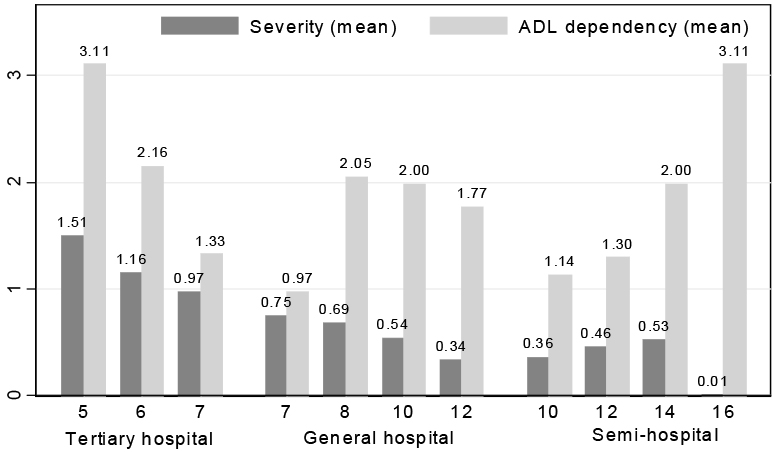J Korean Acad Nurs Adm.
2018 Sep;24(4):288-297. 10.11111/jkana.2018.24.4.288.
Adequacy of Nurse Staffing Level in Integrated Nursing Care
- Affiliations
-
- 1College of Nursing, Seoul National University, Korea.
- 2Division of Nursing · Research Institute of Nursing Science, Hallym University, Korea. ehlee@hallym.ac.kr
- KMID: 2421697
- DOI: http://doi.org/10.11111/jkana.2018.24.4.288
Abstract
- PURPOSE
This study was done to evaluate the adequacy of nurse staffing in integrated nursing care.
METHODS
Statistical data on integrated nursing care from the National Health Insurance Corporation was used in this study. We extracted hospital data and patient data related to patient needs for nursing care. We analyzed the differences in patient needs by staffing level of each type of medical institution.
RESULTS
Approximately 70% of medical institutions provided nursing care by the mid level of nurse staffing, which was 1:6, 1:10 and 1:12 in the tertiary hospital, general hospital and semi-hospital, respectively. The patients' characteristics were significantly different by hospital type. Especially, the distribution of the main diagnosis was completely different between the tertiary hospital and semi-hospital. In the tertiary hospital, the patient needs measured by severity and activities of daily living dependency were higher at higher staffing level than at lower staffing level. However, the nurse staffing was less relevant to the patient needs in the general hospital and semi-hospital.
CONCLUSION
To provide high-quality nursing care, accurate workload forecasting is required at the start, and then the standard nurse staffing level can established based on workload forecasting.
MeSH Terms
Figure
Reference
-
1. Hwang NM. An analysis of the debates on introduction of public caregivers' services in acute medical Centers. Health Welf Policy Forum. 2010; 170:60–71.2. Cho SH, Kim HR. Family and paid caregivers of hospitalized patients in Korea. J Clin Nurs. 2006; 15(8):946–953. DOI: 10.1111/j.1365-2702.2006.01342.x.
Article3. Gil HH, Choi JS. Affecting factors of hospital caregivers on the level of practice, knowledge, and importance of work under no guardian. Korean J Occup Health Nurs. 2012; 21(1):55–65. DOI: 10.5807/kjohn.2012.21.1.55.
Article4. National Health Insurance Service (KR). National Health Insurance integrated nursing care program manual. Wonju: National Health Insurance Service;2016.5. Shin SR, Park KY. Comparing satisfaction with nursing care and factors relevant to hospital revisit intent among hospitalized patients in comprehensive nursing care units and general care units. J Korean Acad Nurs Adm. 2015; 21(5):469–479. DOI: 10.11111/jkana.2015.21.5.469.
Article6. Choi HJ, Koh MS. Comparative study between the patients' satisfaction level of nursing service and revisiting intention of the inpatients according to the wards type. Health Soc Sci. 2014; 37:49–64.7. Boo EH, Ahn KH, Park BK, Hong NS, Son JL, Park MH, et al. Service outcome of comprehensive nursing care and policy direction. Research Report. Goyang, Korea: National Health Insurance Service Ilsan Hospital;2015. vol 2015-20-029.8. Park BK, Boo EH, Lee CH, Ahn KH, Yoon HS, Hong NS, et al. Report on monitoring and evaluation of comprehensive nursing care. Research Report. Goyang, Korea: National Health Insurance Service Ilsan Hospital;2016. vol 2016-20-022.9. Park KO, Yu M, Kim JK. Experience of nurses participating in comprehensive nursing care. J Korean Acad Nurs Adm. 2017; 23(1):76–89. DOI: 10.11111/jkana.2017.23.1.76.
Article10. Joo MS, Jang SN. Nursing experience in a hospital without guardians. Korean J Health Econ Policy. 2015; 21(4):133–157.11. Lee MK, Jung DY. A study of nursing tasks, nurses' job stress and job satisfaction in hospitals with no guardians. J Korean Acad Nurs Adm. 2015; 21(3):287–296. DOI: 10.11111/jkana.2015.21.3.287.
Article12. Cho SH, Song KJ, Park IS, Kim YH, Kim MS, Gong DH, et al. Development of staffing levels for nursing personnel to provide inpatients with integrated nursing care. J Korean Acad Nurs Adm. 2017; 23(2):211–222. DOI: 10.11111/jkana.2017.23.2.211.
Article13. Needleman J, Buerhaus P, Mattke S, Stewart M, Zelevinsky K. Nurse-staffing levels and the quality of care in hospitals. N Engl J Med. 2002; 346(22):1715–1722. DOI: 10.1056/NEJMsa012247.
Article14. Twigg D, Duffield C, Bremner A, Rapley P, Finn J. Impact of skill mix variations on patient outcomes following implementation of nursing hours per patient day staffing: a retrospective study. J Adv Nurs. 2012; 68(12):2710–2718. DOI: 10.1111/j.1365-2648.2012.05971.x.
Article15. Song KJ, Kim EH, Yoo CS, Park HA, Song MS, Park KO. Verification of reliability and validity of KPCS-1 and estimation of nursing time conversion index. J Korean Clin Nurs Res. 2010; 16(2):127–140.16. Kim JE, Park JS, Choi YJ. Pattern analysis of medical expenses of medical institutions over hospital level. KHIDI Brief. 2016; 223:1–12.17. Song KJ, Kim EH, Yoo CS, Park HO, Park KO. Development of KPCS (Korean Patient Classification System for Nurses) based on nursing needs. J Korean Clin Nurs Res. 2009; 15(1):5–17.
- Full Text Links
- Actions
-
Cited
- CITED
-
- Close
- Share
- Similar articles
-
- The Association of Nurse Staffing Levels and Patient Outcome in Intensive Care Units
- The Effects of Long-term Care Hospitals’ Nurse Staffing Level on Patient Outcomes: Differences according to Region
- Relationship between Nurse Staffing and Changes in Pain Level, Infection Severity, and Tissue Integrity: Skin and Mucous Membranes
- The Relationship between Nursing Care Needs and Nurse Staffing in Pulmonology Nursing Units
- Competency of Nursing Performance and Job Satisfaction of Operating Room Nurse by Type of Nurse Staffing


